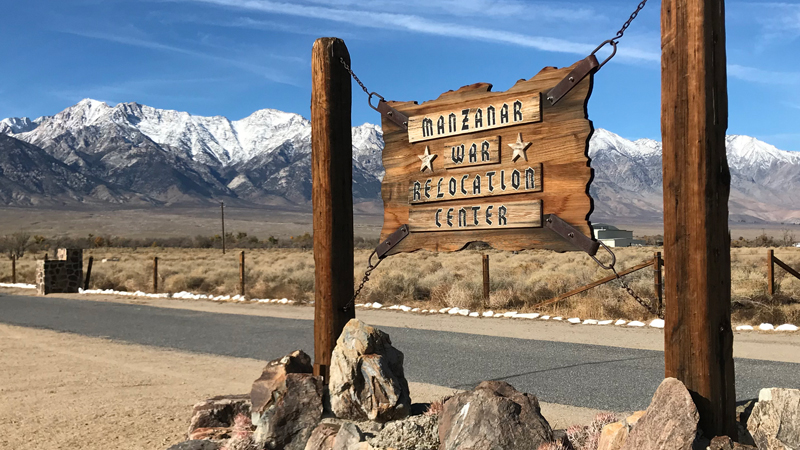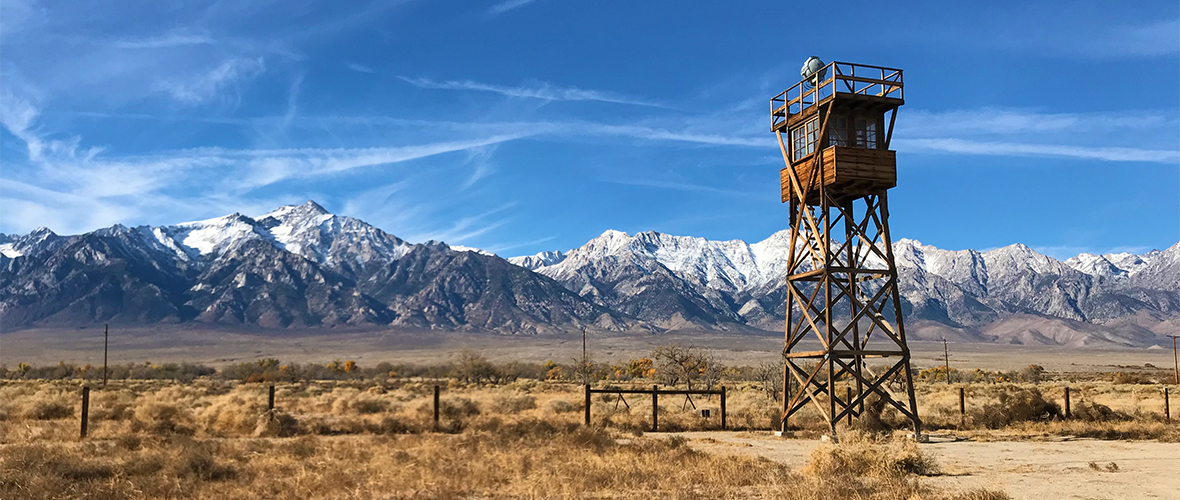
Sitting in California’s Owens Valley, 230 miles north of Los Angeles, with the majestic, snow-capped Sierra Nevada to the west and the Inyo Mountains to the east, Manzanar is a beautiful historic site with an ugly and almost inconceivable history.
In 1942, the United States government ordered more than 110,000 men, women, and children to leave their homes and detained them in remote, military-style camps. Manzanar War Relocation Center was one of ten camps where Japanese American citizens and resident Japanese aliens were interned during World War II and has been identified as the best preserved camp.
Today Manzanar National Historic Site preserves and interprets the legacy of Japanese American incarceration in the United States and shares their stories of triumph and tragedy.
Manzanar Historic Site features restored sentry posts at the camp entrance, a replica of a camp guard tower, a 3.2 self-guided tour road and wayside exhibits, old building foundations, guided tours, a museum and historic film, reconstructed barracks with exhibits, the camp cemetery, excavated gardens and ponds, and a bookstore and gift shop. You’ll also be able to listen to oral histories of Manzanar and see artifacts such as bird pins, furniture, clothing, utensils, cemetery offerings, photographs, significant cultural items, and other tangible resources.
Additionally, the Manzanar Museum also covers:
- The Owens Valley Paiute, who inhabited the area from AD 600 to the early 1900s
- The former town of Manzanar and the early ranching and farming period from 1860-1930
- The World War II confinement of Japanese Americans from 1942-1945
- The role water played in shaping the history of the Owens Valley

Visiting Manzanar
When planning our week-long Thanksgiving road trip to Death Valley National Park, I researched things to do along Highway 395, thinking we might have time to stop and do a thing or two on our way to the park. When I discovered Manzanar National Historic Site, I thought it would be a great opportunity for Natalie and Carter to learn more about the racial hysteria surrounding Word War II and the resulting internment of Japanese Americans.
Unfortunately, we took a different path to Death Valley, stopping at Red Rock Canyon State Park. But my in-laws, who joined us for the last half of our trip, stopped on their way to the park and highly recommended that we take 395 home and stop on the way.
We took their advice and were able to visit Manzanar for about 90 minutes and it was incredible both in a horrible, almost embarrassing way and in an awe-inspiring, beautiful way.
The minute you step off the parking area onto the land at Manzanar, you can feel that you’re somewhere important.
While Brian and I both learned about the concentration camps in school, and Natalie and Carter’s history lessons have touched on, our teachings were all a bit glossy and smoothed over. None of us were quite prepared for the reality that is Manzanar. The exhibits, displays, and stories of those interned were shocking, heartbreaking, and incredibly sad.
We felt outrage that this could happen, horror that the American people and government could actually do this, embarrassment that people actually believed the camps were the best course of action, and sadness for the families, individuals, and children that lived through this era. But at the same time, we were incredibly impressed by those interned who made the best of a terrible situation and felt admiration for those who created meaningful lives, and raised children here.
If you only have 60-90 minutes like we did, start your visit at the Visitor Center and Museum, then walk over to the buildings and exhibits that make up Block 14. If you have half a day, continue your visit with the 3.2 mile self guided driving tour around the site to experience the Manzanar landscape. If you stop and explore the area, you’ll find eleven Japanese gardens and ponds that have been excavated, the Judo Dojo site, Hospital complex site, Administration area, and historic orchards.
The Manzanar Committee
The Manzanar Committee, dedicated to educating and raising public awareness about the incarceration and violation of civil rights of persons of Japanese ancestry during World War ll, is a volunteer committee that spearheaded efforts to preserve Manzanar. Their efforts resulted in Manzanar being designated a California Historical Landmark in 1972, added to the National Register of Historic Places and registered as a Los Angeles Historic-Cultural Monument in 1976, designated a National Historic Site in 1992, named a National Historic Landmark in 1985, and in 1992, established as Manzanar National Historic Site.
Know Before You Go
- Manzanar National Historic Site is located on Manzanar Reward Road at 5001 HWY 395, Independence, California 93526 in Inyo County, 10 miles north of Lone Pine and 7.3 miles south of Independence.
- Admission is free.
- The 814 acre site is open every day from dawn to dusk. Closed Christmas Day.
- The Visitor Center is open from 9:00 am to 4:30 pm.
- Block 14, including Barracks 1, Barracks 8, Women’s Latrine, and Mess Hall Exhibits, are open from 9:00 am to 4:15 pm.
- In front of the Manzanar Visitor Center, site stones adorned with the names of each concentration camp and the number of people interned there.
- Access maps of the site.
- Manzanar Store is operated by Manzanar History Association (MHA). The store features a wide selection of books, DVDs, art prints, posters, T-shirts, gift items, and more.
- If you are going to explore the site outdoors, be sure to bring water as it can be very hot and reach temperatures of almost 110 degrees.
- Pets are allowed on the site, however they must be on a leash at all times and you must clean up after your pets. Pets are NOT allowed in any buildings including the Visitor Center. Pets are NOT allowed within the fenced area of the cemetery.
- If you walk through the site, please remember that there is no collecting of artifacts. Leave everything where you find it.








